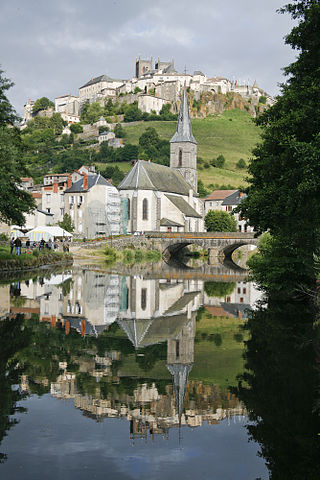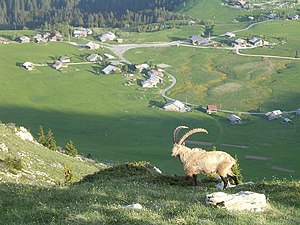Prologue - Saint-Flour - 4.45 km
 |
| Picturesque Saint-Flour (Photo:WikiCommons) |
The prologue itself is just under 4.5 kilometers and features a nice rise that the race has categorized as a cat. 4 climb. It definitely won't be a prologue for only the specialists and GC riders will need to be on their toes so they either gain some advantage or don't lose time like water through a colander.
Stage 1 - Saint-Flour to Brioude - 144.6 km
This is a stupid stage. Stupid. Who in their right mind would be like, "Yes, let's put 5 climbs in the first half of the stage and then have a long downhill followed by 50 kilometers of flat terrain to finish the stage off. This is going to be great racing!"
Now the last 50 kilometers are filled with some of those small, sharp rises that can definitely sting the legs a bit but should be any issue. Still though, it would be nice if they could spread the climbs out a bit. In the first 33 kilometers, the race goes over 3 categorized climbs. Now, I can imagine that a breakaway might form early, especially those interested in the KOM classification, and get away to allow the pack to get off to an easier start. Or there could be a team that drills it from the beginning over the climbs in the attempt to shed some sprinters.
5 climbs in the first 63 kilometers sounds awesome but right after that, there is a downhill that gradually descends for the next 30 kilometers excluding a plateau section of about 5 or so kilometers. Once the descent is over, the chase will be on. 50 kilometers of flat to sorta flat terrain that finishes with 3 finishing circuits in Brioude.
 |
| Saint Julien Bascilica; largest Christian church in the region Photo: WikiCommons |
Stage 2 - Brioude to Saint-Galmier - 142.6 km
This is looking to be a cracker of a stage with 3 categorized climbs as well as a few uncategorized kickers that will certainly break things up in the finale as well as a slightly uphill finish. It is going to be gooooood.
There is 6 kilometers of neutral before the race goes uphill for the next 40 kilometers to the Cote de la Chaise-Dieu. Nothing too steep but just a consistent drag up to the summit at 1045 meters. Then the race takes on a saw-tooth profile; up and down, up and down. The race takes a sharp descent before going right back uphill on the Cote de Medeyrolles, a category 2 climb. Another descent leads them into the rolling lunch for the day before another short but steep climb, the Cote de la Chaulme, before descending into the valley to Saint-Galmier. The race calms a bit before hitting an uncategorized climb on the Saint-Galmier city circuit. This is followed by a descent that leads into a little kicker to the finish line, which will most likely suit a small breakaway or some punchy sprinters like Luka Pibernik, Silvio Herklotz or about half of the Australian team.
Stage 3 - Montrond-les-Bains to Paray-le-Monial - 150.7 km
This is the best opportunity for the sprinters to get a clean bunch gallop before the major hills begin. Beginning from the small town of Montrond-les-Bains in the Rhone-Alpes region, the race heads due north to Paray-le-Monial. The is only one small bump along the way, a cat 4 climb that is just a kilometer and a half long. Expect a breakaway to get away for a long time before being caught headed into the finale. The peloton must beware though. With small teams, they must be on their toes and not let a dangerous breakaway get up the road because the long ride might lull the chase to sleep for a bit too long.
 |
| The Tour de l'Basilica continues with this one from Paray-le-Monial The Sacre-Coeur (Sacred Heart) was built as a replica of the famed Cluny Abbey, whose monks were the lords of Paray-le-Monial at the time. Photo:WikiCommons |
Stage 4 - Saint Vulbas to Plateau de Solaison - 165.3 km
Finally...the mountains. Everyone better be ready because shit is going to get very hard quite soon. Departing from Saint Vulbas' not very exclusive International Meeting Centre, the race goes takes it easy for the first half of the race, only going up the cat. 4 Cote de Premeyzel. The race gradually takes in a few more hills including the 4-kilometer Cote de Cruseilles. Of course, these are just appetizers for the main event, the climb up to the Plateau de Solaison.
 |
| So majestic. Ram on the Plateau de Solaison Photo: WikiCommons |
In any case, the racers better be on their toes so there is not another situation like last year, i.e. Ruben Fernandez, where a rider sneaks away on the first mountain stage, takes advantage of other riders looking at one another and takes a stranglehold on the overall GC.
Stage 5 - Bons-en-Chablais to Les Carroz d'Araches - 101.6 km
After the slog up to Plateau de Solaison, the race will be going with the shorter but faster approach. Only 102 kilometers in length, the course is lumpy and features 2 categorized climbs including the cat. 2 Col de Saxel and the mountain top finish on Les Carroz-d'Araches, which is considered a cat. 1 climb.
The Col de Saxel isn't very tough at all at under 5% average for the duration of the climb. Following the descent, the race goes over some bumpy stuff on the way to the Les Carroz-d'Araches climb. It is a two-part climb with the first part going uphill for about 6.5 kilometers before leveling out. The next part kicks up again at Araches La Frasse, where it goes uphill for the next 3.3 kilometers at about 5.5% to the village of Les Carroz. Should be a nice romp in mountains but won't kill the legs with anything too steep.
------
The next two days are just 200 kilometers combined but they will be the crux of the Tour de l'Avenir. They feature 6 category 1 or hors category climbs and include climbs like La Toussuire, le Col de la Croix de Fer and the Cormet de Roselend. It is going to be some explosive stages, that is for certain.
Stage 6 - Saint-Gervais to La Rosiere-Montvalezan - 108.4 kilometers
Leaving the town of Saint (Ricky) Gervais, the race goes up a slight 3 percent grade for the first 10 kilometers to the hamlet of Megeve before heading downhill to the base of the first big climb, the Col de Saisies. The Saisies (profile) is around 14 kilometers in length and while the average is only 5%, the gradient does fluctuate and has ramps that hit 10% in spots.
Following a long descent down to Beaufort, the race goes up the Cormet de Roselend, a hors (beyond) category climb that is a certainly a drag at 20.3 kilometers and a 6% average. Just like the Saisies, the Roselend does tend to jump around with gradients with spots that go up to 10% while others are a pedestrian 5%. The race says that the Roselend tops out at 1915 meters but the climb proper goes up to 1967m so the race will pass somewhere between there.
What comes after a 20km long ascent? Of course. A 20 kilometer long descent. The riders plunge back down into the valley to the hamlet of Bourg-Saint-Maurice and almost immediately start going back up to the summit finish at Montvalezan. The finishing climb is over 15.6 kilometers in length and is hard in the middle and easier on both ends. The middle kilometers reach averages over 9% in gradient while the climb finishes with kilometers between 4 and 6%.
To review, that is a total of roughly 50 kilometers of climbing in 108 kilometers. And there is still one stage to go...
Stage 7 - Saint-Michel de Maurienne to La Toussuire - 95.1 kilometers
This is it. There is no turning back. It has been a long week and there is just one more test. 3 big ass climbs with a finish that gives the best pros a run for their money. Many will have such wooden legs that they will need to get an ax and splitter to be able to coax their legs to get onto their bikes.
The organizers added 11 kilometers of neutral to the stage to be able to let the riders get a little warm up because once the flag drops, the racing will be going balls out.
Let's go back to Will at Cycling Challenge to give us a look at Col du Mollard and the Col de la Croix de Fer. You can clump the climbs together and create a beast with two summits over 40 kilometers in length. The climbs gain 2067 meters and both have some pretty steep bits with the Croix de Fer hitting some averages near 9% late on the climb. Ouch.
After another half hour worth of descending, the racers will hit their final challenge of the race. The hors categorie La Toussuire. La Toussuire, used twice in the Tour de France, is 19 kilometers in length and has 1145 meters in elevation gain. The elevation gain is fairly steady and at this point, it will be a test who hasn't cracked yet. With 60 kilometers of climbing on tap and over 3000 meters of climbing on top of 7 stages from the week prior, any GC rider will be on call.
-----
Well there you have it. The 8 days of the Tour de l'Avenir. I must say, this is one of the most impressive editions of the race in recent years and it is great to see it back to form.
Here is the link to all of the stage profiles for the Tour de l'Avenir from their official website.
The teams for the 51st Tour de l'Avenir include:
France (Chetout, Latour, Maison, Martin, Jauregui and Gouault)
Switzerland (Bohli, Chavanne, Kung, Spengler, Schir, Leinhard)
Belgium
Denmark (A. Kragh, S. Kragh, Cort, Carbel, Wurtz, M. Pedersen)
Norway (Eiking, Skjerping, Bystrom, Svendsen, Lunke, Roinas)
Netherlands (Teunissen)
Russia
Kazakhstan
Austria
Great Britain (Doull, Dibben, D. Pearson)
Italy
Spain (M. Gonzalez, O. Gonzalez, Iturria, Aristi, Roson, Soler)
USA (Eisenhart, Perrin, Owen)
Luxembourg (Kirsch)
Colombia (C. Ramirez, M.A. Lopez, Rozo, Contreras, Gaviria, B. Ramirez)
Germany (Schachmann, Buchmann, Herklotz, J. Koch, Plarre, Vogt)
Australia (Haig, Power, Ewan)
Portugal (J. Silva, Ribeiro, Matos, Ferreira, Reis, Magalhaes)
Slovenia
Poland (Kasperkiewicz)
UCI Mixed Team
Full roster on the Tour de l'Avenir website. Now time to work out the favorites...
No comments:
Post a Comment